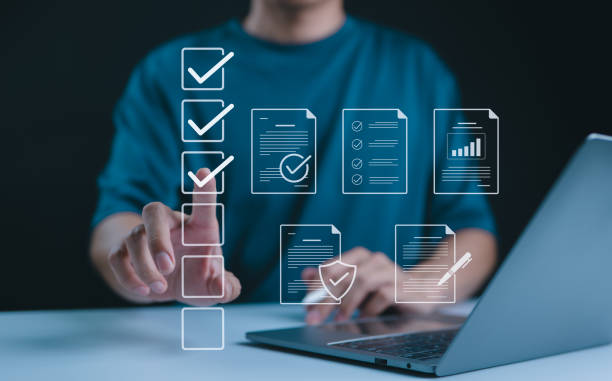What is On-Page SEO and Why Does it Matter?

#OnPageSEO refers to a set of actions you take within your website to improve its ranking in search engine results.
These actions include content optimization, site structure, title tags, meta descriptions, and other factors related to the site itself.
The importance of On-Page SEO lies in the fact that it helps search engines better understand the content of your site and display it to users who are looking for relevant information.
A strong On-Page SEO strategy makes your site considered a credible and relevant source, which leads to increased visits and improved conversion rates.
Without proper On-Page SEO, even the best content may be lost among a multitude of websites.
On-Page SEO ensures that your site ranks for relevant keywords, attracts more organic traffic, and ultimately, achieves your business goals.
The most important factors in On-Page SEO include using appropriate keywords, creating quality and relevant content, optimizing images, and improving site loading speed.
On-Page SEO is an ongoing process and needs to be reviewed and updated to keep up with changes in search engine algorithms.
By following the principles of On-Page SEO, you can ensure that your site is always in the best possible position to attract organic traffic.
Are you tired of losing business opportunities due to not having a professional company website?
Rasaweb helps you with professional corporate website design:
✅ Build a powerful and reliable image of your brand
✅ Turn website visitors into loyal customers
⚡ Get a free consultation now!
Keyword Research: The Foundation of On-Page SEO
![]()
Keyword research is the process of identifying the words and phrases that users use to search in search engines.
These keywords should be relevant to your business, products, and services.
Choosing the right keywords is the first and most important step in On-Page SEO, as the content of your site should be optimized based on these keywords.
To conduct keyword research, you can use various tools such as Google Keyword Planner, Ahrefs, and Semrush.
These tools help you find search volume, competition, and related keywords.
You can also use other techniques such as reviewing competitor sites, asking customers, and using Google search suggestions to find suitable keywords.
After identifying keywords, you should use them strategically in your site content.
This includes using keywords in titles, meta descriptions, main text, and image tags.
However, you should be careful to avoid overusing keywords, as this may result in your site being penalized by Google.
Your goal should be to create quality, relevant content that naturally incorporates keywords.
Content Optimization for Search Engines and Users

Content is king! This sentence has been heard many times, but its importance in On-Page SEO is still very high.
Quality and relevant content is not only attractive to search engines, but also valuable to users and makes them stay longer on your site and become customers.
To optimize content, you need to pay attention to a few points:
1.
Keywords: Use keywords naturally in your text.
Avoid overusing keywords, as this may make your content appear unnatural.
2.
Structure: Present your content in an organized and structured manner.
Use titles, subtitles, bullet points, and images to divide the text and increase its readability.
3.
Length: The length of your content should be appropriate to the topic.
Try to provide users with comprehensive and complete information as much as possible.
Google likes long and comprehensive content more.
4.
Freshness: Update your content regularly.
Old and outdated content is not only unattractive to users, but may also reduce your site’s ranking.
5.
Value: Your content should be valuable to users.
Try to provide them with new and useful information that they cannot find elsewhere.
| Element | Description |
|---|---|
| Main Title | Should be attractive, relevant, and include the main keyword. |
| Subtitles | Used to divide the text and increase readability. |
| Main Text | Should contain accurate, comprehensive, and relevant information to the topic. |
| Images | Should be high quality and have a suitable alt tag. |
Optimizing Title and Meta Descriptions

Title Tags and Meta Descriptions are HTML elements that are displayed in Google search results.
These elements play an important role in attracting users and encouraging them to click on your site’s link.
The title tag should be short, attractive, and contain the main keyword.
The length of the title tag should not exceed 60 characters, otherwise it will be truncated in the search results.
Meta descriptions should be a summary of the page content and encourage users to click.
The length of meta descriptions should not exceed 160 characters.
Meta descriptions should be unique and different for each page of your site.
Using relevant keywords in meta descriptions can help improve your site’s ranking.
For example, if your page is about “buying sports shoes,” the title tag could be “Buy Sports Shoes at the Best Price | [Your Site Name]” and the meta description could be “Buy the best sports shoes with a special discount from [Your Site Name].
Free shipping throughout the country.”
How much does losing business leads due to a non-professional site cost you? Solve this problem forever with professional corporate website design by Rasaweb!
✅ Increase credibility and trust of potential customers
✅ Easier attraction of new business leads
⚡ Get a free consultation now!
Improving URL Structure and Internal Links

URL structure and internal links play an important role in On-Page SEO.
URLs should be short, descriptive, and contain the main keyword.
Avoid using uppercase letters, spaces, and special characters in URLs.
URLs should be such that users and search engines can easily understand the content of the page.
Internal links are links that connect different pages of your site.
Internal links help search engines understand the structure of your site and find important pages.
Internal links also help users to easily navigate your site and find the information they need.
When creating internal links, you should pay attention to a few points.
First, the links should be relevant to the page content.
Second, the anchor text should be descriptive and contain the main keyword.
Third, the links should point to important and relevant pages of your site.
By improving URL structure and internal links, you can help search engines better understand your site and improve your site’s ranking.
On-Page SEO is very important in this section.
Optimizing Images and Videos

Images and videos play an important role in the attractiveness and engagement of users with your site.
However, if images and videos are not properly optimized, they may slow down the site loading speed and negatively impact On-Page SEO.
To optimize images, you need to pay attention to a few points.
First, the image size should be as small as possible.
You can use image compression tools to reduce the size of images without losing quality.
Second, images should have a suitable alt tag.
The alt tag helps search engines understand the content of the image.
The alt tag should be descriptive and contain the main keyword.
To optimize videos, you should upload them to video platforms such as YouTube and then embed them on your site.
Videos should have appropriate titles, descriptions, and tags.
You should also create a video sitemap and submit it to Google.
By optimizing images and videos, you can improve your site’s loading speed, increase your site’s ranking, and improve user experience.
These factors are critical for On-Page SEO.
Improving Site Loading Speed

Site loading speed is one of the most important factors in On-Page SEO and user experience.
Users who have to wait more than a few seconds for a web page to load usually leave the site and visit another site.
Google also attaches great importance to site loading speed, and sites with higher speeds achieve a better ranking in search results.
To improve site loading speed, you can use various methods.
Some of these methods include:
1.
Image Optimization: Reduce image size as much as possible.
2.
Using CDN: Use a Content Delivery Network (CDN) to distribute your site’s content around the world.
3.
Activating Gzip Compression: Gzip compression reduces the size of your site’s files.
4.
Using Cache: Use cache to store static versions of your site’s pages.
5.
Reducing HTTP Requests: Reduce the number of HTTP requests by combining CSS and JavaScript files.
| Indicator | Value |
|---|---|
| Page Loading Speed (Desktop) | Less than 3 seconds |
| PageSpeed Insights Score | Above 80 |
Mobile-Friendly Optimization

Considering that most internet users access websites through mobile devices, optimizing for mobile is a necessity.
Sites that are not optimized for mobile provide a poor user experience, and users are more likely to leave the site.
Google also gives a better ranking to sites that are optimized for mobile.
To optimize for mobile, you should use Responsive Design.
Responsive design means that your site automatically adapts to the screen size of different devices (mobile, tablet, desktop).
You should also make sure that the fonts are readable, the buttons are large enough, and the site navigation is easy.
In addition to responsive design, you should also pay attention to the site loading speed on mobile devices.
Mobile users usually use slower internet, so the site loading speed is more important to them.
There are various tools such as Google PageSpeed Insights that help you check your site’s loading speed on mobile devices and identify problems.
On-Page SEO for mobile is a principle.
Are you tired of losing business opportunities due to not having a professional company website?
Rasaweb helps you with professional corporate website design:
✅ Build a powerful and reliable image of your brand
✅ Turn website visitors into loyal customers
⚡ Get a free consultation now!
Using Schema Markup

Schema Markup is an HTML code that helps search engines better understand the content of your site.
Schema Markup provides search engines with more information about the page content, such as the type of content, author, publication date, etc.
By using Schema Markup, you can create Rich Snippets.
Rich Snippets display more information in Google search results, such as ratings, prices, images, etc.
Rich Snippets increase your site’s CTR (click-through rate) and attract more users to your site.
There are different types of Schema Markup that you can use for different types of content.
Some of the most common types of Schema Markup include: Article schema, Product schema, Review schema, Event schema, and LocalBusiness schema.
By using Schema Markup, you can help search engines better understand your site, create rich search results, increase your site’s CTR, and attract more traffic.
On-Page SEO is very important in this section.
Monitoring and Measuring On-Page SEO Results

On-Page SEO is an ongoing process and requires monitoring and measurement.
You should regularly check the performance of your site and measure the results of your On-Page SEO efforts.
This helps you identify the strengths and weaknesses of your strategy and make the necessary changes.
To monitor and measure On-Page SEO results, you can use various tools such as Google Analytics and Google Search Console.
Google Analytics gives you detailed information about site traffic, user behavior, and conversion rate.
Google Search Console gives you information about your site’s performance in Google search results, such as keyword ranking, number of impressions, and click-through rate.
By using these tools, you can regularly check the performance of your site and measure the results of your On-Page SEO efforts.
By doing so, you can improve your On-Page SEO strategy and increase your site’s ranking in Google search results.
On-Page SEO should be reviewed frequently.
FAQ
| Question | Answer |
|---|---|
| What is a Meta Title and why is it important in On-Page SEO? | The Meta Title is the most important element of On-Page SEO, displayed at the top of the browser tab and search results. This title helps search engines and users understand the main topic of the page and should include the main keyword. |
| What role does the Meta Description play in On-Page SEO? | The Meta Description is a short summary of the page content displayed below the title in the search results. Although it does not directly affect ranking, its attractiveness can increase the click-through rate (CTR). |
| How should keywords be used in page content? | Keywords should be used naturally and relevantly in strategic locations such as the title, headings, first paragraph, and body text. Avoid excessive keyword stuffing. |
| What is the importance of quality and comprehensive content in On-Page SEO? | Quality, unique, informative, and comprehensive content that meets the user’s needs is of high importance. Search engines give a higher ranking to content that creates real value. |
| What is the application of heading tags (H1-H6) in the structure of On-Page SEO? | Heading tags (H1, H2, H3, etc.) are used to structure content and specify the importance of different sections. H1 is the main title of the page, and each page should have only one H1. Other tags are used for subtitles. |
| How to optimize images to improve On-Page SEO? | To optimize images, use descriptive Alt Text that includes relevant keywords, reduce the image file size without losing quality, and use meaningful and relevant file names. |
| What are the features of a friendly URL for On-Page SEO? | A friendly URL should be short, readable, descriptive, include the main keywords, and without extra characters. The URL structure should be hierarchical and logical so that it is understandable for both users and search engines. |
| How does Internal Linking help On-Page SEO? | Internal Linking helps users and search engine crawlers to better understand the site structure by connecting related pages, transfer page authority and increase the time the user spends on the site. |
| What is the impact of page loading speed on On-Page SEO? | High loading speed is critical for both user experience and SEO ranking. Slower pages may be ignored by search engines and lead to an increase in the Bounce Rate. |
| Why is Mobile-Friendliness so important in On-Page SEO? | Given the increasing number of searches via mobile devices, having a responsive and mobile-friendly site is essential for user experience and ranking in search results (Google’s Mobile-First Indexing). |
And other services of Rasa Web advertising agency in the field of advertising
Intelligent Sales Automation: A combination of creativity and technology to improve SEO ranking by SEO-oriented content strategy.
Intelligent Direct Marketing: A combination of creativity and technology to attract customers by SEO-oriented content strategy.
Intelligent Brand Identity: A creative platform to improve site visits with Google Ads management.
Intelligent Digital Advertising: A fast and efficient solution for campaign management with a focus on marketing automation.
Intelligent Custom Software: An effective tool to increase sales by customizing the user experience.
And more than hundreds of other services in the field of internet advertising, advertising consulting and organizational solutions
Internet Advertising | Advertising Strategy | Advertorial
Resources
The Complete Guide to On-Page SEO from Ahrefs
,On-Page SEO Optimization from Moz
,The Complete Guide to On-Page SEO from Search Engine Journal
,On-Page SEO: The Ultimate Guide from Semrush
? For visibility and growth of your business in the digital world, Rasaweb Afarin is your best companion. From professional WordPress website design to search engine optimization (SEO) and intelligent social media management, we offer everything you need for your online shine with high expertise and experience. Let your business shine powerfully on the web and achieve its lofty goals.
📍 Tehran, Mirdamad Street, next to Central Bank, South Kazerun Alley, Ramin Alley, No. 6
“`



